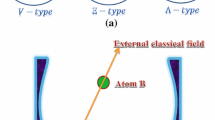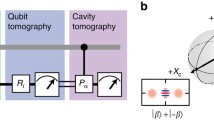Abstract
We show that in some cases the coherent state can have a larger violation of the Leggett–Garg inequality (LGI) than the cat state by numerical calculations. To achieve this result, we consider the LGI of the cavity mode weakly coupled to a zero-temperature environment as a practical instance of the physical system. We assume that the bosonic mode undergoes dissipation because of an interaction with the environment but is not affected by dephasing. Solving the master equation exactly, we derive an explicit form of the violation of the inequality for both systems prepared initially in the coherent state \(|\alpha \rangle \) and the cat state \((|\alpha \rangle +|-\alpha \rangle )\). For the evaluation of the inequality, we choose the displaced parity operators characterized by a complex number \(\beta \). We look for the optimum parameter \(\beta \) that lets the upper bound of the inequality be maximum numerically. Contrary to our expectations, the coherent state occasionally exhibits quantum quality more strongly than the cat state for the upper bound of the violation of the LGI in a specific range of three equally spaced measurement times (spacing \(\tau \)). Moreover, as we let \(\tau \) approach zero, the optimized parameter \(\beta \) diverges and the LGI reveals intense singularity.
Graphic Abstract















Similar content being viewed by others
Data Availability Statement
This manuscript has no associated data or the data will not be deposited. [Author’s comment: The data obtained by numerical calculations and C++ programs will be available from the corresponding author upon reasonable request.]
References
J.S. Bell, On the Einstein Podolsky Rosen paradox. Physics 1(3), 195–200 (1964). https://doi.org/10.1103/PhysicsPhysiqueFizika.1.195
A.J. Leggett, A. Garg, Quantum mechanics versus macroscopic realism: Is the flux there when nobody looks? Phys. Rev. Lett. 54(9), 857–860 (1985). https://doi.org/10.1103/PhysRevLett.54.857
Č. Brukner, S. Taylor, S. Cheung, V. Vedral, ‘Quantum entanglement in time’, arXiv:quant-ph/0402127
C. Emary, N. Lambert, F. Nori, Leggett–Garg inequalities. Rep. Prog. Phys. 77(1), 016001 (2014). https://doi.org/10.1088/0034-4885/77/1/016001
S.F. Huelga, T.W. Marshall, E. Santos, Proposed test for realist theories using Rydberg atoms coupled to a high-\(Q\) resonator. Phys. Rev. A 52(4), R2497–R2500 (1995). https://doi.org/10.1103/PhysRevA.52.R2497
H. Chevalier, A.J. Paige, H. Kwon, M.S. Kim, ‘Violating the Leggett-Garg inequalities with classical light’, arXiv:2009.02219
Y.-N. Chen, C.-M. Li, N. Lambert, S.-L. Chen, Y. Ota, G.-Y. Chen, F. Nori, Temporal steering inequality. Phys. Rev. A 89(3), 032112 (2014). https://doi.org/10.1103/PhysRevA.89.032112
M. Łobejko, J. Łuczka, J. Dajka, Leggett–Garg inequality for qubits coupled to thermal environment. Phys. Rev. A 91(4), 042113 (2015). https://doi.org/10.1103/PhysRevA.91.042113
A. Friedenberger, E. Lutz, Assessing the quantumness of a damped two-level system. Phys. Rev. A 95(2), 022101 (2017). https://doi.org/10.1103/PhysRevA.95.022101
H. Azuma, M. Ban, The Leggett–Garg inequalities and the relative entropy of coherence in the Bixon-Jortner model. Eur. Phys. J. D 72(10), 187 (2018). https://doi.org/10.1140/epjd/e2018-90275-7
M. Thenabadu, M.D. Reid, Leggett–Garg tests of macrorealism for dynamical cat states evolving in a nonlinear medium. Phys. Rev. A 99(3), 032125 (2019). https://doi.org/10.1103/PhysRevA.99.032125
A. Palacios-Laloy, F. Mallet, F. Nguyen, P. Bertet, D. Vion, D. Esteve, A.N. Korotkov, Experimental violation of a Bell’s inequality in time with weak measurement. Nat. Phys. 6, 442–447 (2010). https://doi.org/10.1038/nphys1641
M.E. Goggin, M.P. Almeida, M. Barbieri, B.P. Lanyon, J.L. O’Brien, A.G. White, G.J. Pryde, Violation of the Leggett–Garg inequality with weak measurements of photons. Proc. Natl. Acad. Sci. USA 108(4), 1256–1261 (2011). https://doi.org/10.1073/pnas.1005774108
G.C. Knee, S. Simmons, E.M. Gauger, J.J.L. Morton, H. Riemann, N.V. Abrosimov, P. Becker, H.-J. Pohl, K.M. Itoh, M.L.W. Thewalt, G.A.D. Briggs, S.C. Benjamin, Violation of a Leggett–Garg inequality with ideal non-invasive measurements. Nat. Commun. 3, 606 (2012). https://doi.org/10.1038/ncomms1614
D.F. Walls, G.J. Milburn, Quantum Optics (Springer-Verlag, Berlin, 1994)
S.M. Barnett, P.M. Radmore, Methods in theoretical quantum optics (Oxford University Press, Oxford, 1997) Sect. 5.6
B. Yurke, D. Stoler, Generating quantum mechanical superpositions of macroscopically distinguishable states via amplitude dispersion. Phys. Rev. Lett. 57(1), 13–16 (1986). https://doi.org/10.1103/PhysRevLett.57.13
W. Schleich, M. Pernigo, F.L. Kien, Nonclassical state from two pseudoclassical states. Phys. Rev. A 44(3), 2172–2187 (1991). https://doi.org/10.1103/PhysRevA.44.2172
V. Bužek, A. Vidiella-Barranco, P.L. Knight, Superpositions of coherent states: squeezing and dissipation. Phys. Rev. A 45(9), 6570–6585 (1992). https://doi.org/10.1103/PhysRevA.45.6570
M.S. Kim, V. Bužek, Schrödinger-cat states at finite temperature: influence of a finite-temperature heat bath on quantum interferences. Phys. Rev. A 46(7), 4239–4251 (1992). https://doi.org/10.1103/PhysRevA.46.4239
R.F. Bishop, A. Vourdas, Displaced and squeezed parity operator: its role in classical mappings of quantum theories. Phys. Rev. A 50(6), 4488–4501 (1994). https://doi.org/10.1103/PhysRevA.50.4488
K. Banaszek, K. Wódkiewicz, Nonlocality of the Einstein-Podolsky-Rosen state in the Wigner representation. Phys. Rev. A 58(6), 4345–4347 (1998). https://doi.org/10.1103/PhysRevA.58.4345
K. Banaszek, K. Wódkiewicz, Testing quantum nonlocality in phase space. Phys. Rev. Lett. 82(10), 2009–2013 (1999). https://doi.org/10.1103/PhysRevLett.82.2009
M.S. Kim, J. Lee, Test of quantum nonlocality for cavity fields. Phys. Rev. A 61(4), 042102 (2000). https://doi.org/10.1103/PhysRevA.61.042102
H. Jeong, W. Son, M.S. Kim, D. Ahn, Č. Brukner, Quantum nonlocality test for continuous-variable states with dichotomic observables. Phys. Rev. A 67(1), 012106 (2003). https://doi.org/10.1103/PhysRevA.67.012106
N. Lambert, C. Emary, Y.-N. Chen, F. Nori, Distinguishing quantum and classical transport through nanostructures. Phys. Rev. Lett. 105(17), 176801 (2010). https://doi.org/10.1103/PhysRevLett.105.176801
N. Lambert, Y.-N. Chen, F. Nori, Unified single-photon and single-electron counting statistics: from cavity QED to electron transport. Phys. Rev. A 82(6), 063840 (2010). https://doi.org/10.1103/PhysRevA.82.063840
G.-Y. Chen, N. Lambert, C.-M. Li, Y.-N. Chen, F. Nori, Delocalized single-photon Dicke states and the Leggett–Garg inequality in solid state systems. Sci. Rep. 2, 869 (2012). https://doi.org/10.1038/srep00869
C.-M. Li, N. Lambert, Y.-N. Chen, G.-Y. Chen, F. Nori, Witnessing quantum coherence: from solid-state to biological systems. Sci. Rep. 2, 885 (2012). https://doi.org/10.1038/srep00885
C. Emary, N. Lambert, F. Nori, Leggett–Garg inequality in electron interferometers. Phys. Rev. B 86(23), 235447 (2012). https://doi.org/10.1103/PhysRevB.86.235447
J. Kofler, Č. Brukner, Classical world arising out of quantum physics under the restriction of coarse-grained measurements. Phys. Rev. Lett. 99(18), 180403 (2007). https://doi.org/10.1103/PhysRevLett.99.180403
S.V. Moreira, A. Keller, T. Coudreau, P. Milman, Modeling Leggett–Garg-inequality violation. Phys. Rev. A 92(6), 062132 (2015). https://doi.org/10.1103/PhysRevA.92.062132
H.-Y. Ku, N. Lambert, F.-J. Chan, C. Emary, Y.-N. Chen, F. Nori, Experimental test of non-macrorealistic cat states in the cloud. npj Quantum Inf. 6, 98 (2020). https://doi.org/10.1038/s41534-020-00321-x
M.M. Wilde, A. Mizel, Addressing the clumsiness loophole in a Leggett-Garg test of macrorealism. Found. Phys. 42(2), 256–265 (2012). https://doi.org/10.1007/s10701-011-9598-4
G.C. Knee, K. Kakuyanagi, M.-C. Yeh, Y. Matsuzaki, H. Toida, H. Yamaguchi, S. Saito, A.J. Leggett, W.J. Munro, A strict experimental test of macroscopic realism in a superconducting flux qubit. Nat. Commun. 7, 13253 (2016). https://doi.org/10.1038/ncomms13253
R.J. Birrittella, P.M. Alsing, C.C. Gerry, The parity operator: applications in quantum metrology featured. AVS Quantum Sci. 3(1), 014701 (2021). https://doi.org/10.1116/5.0026148
B.-G. Englert, N. Sterpi, H. Walther, Parity states in the one-atom maser. Opt. Commun. 100(5–6), 526–535 (1993). https://doi.org/10.1016/0030-4018(93)90254-3
L. Cohen, D. Istrati, L. Dovrat, H.S. Eisenberg, Super-resolved phase measurements at the shot noise limit by parity measurement. Opt. Express 22(10), 11945–11953 (2014). https://doi.org/10.1364/OE.22.011945
N. Lambert, R. Johansson, F. Nori, Macrorealism inequality for optoelectromechanical systems. Phys. Rev. B 84(24), 245421 (2011). https://doi.org/10.1103/PhysRevB.84.245421
J.R. Johansson, N. Lambert, I. Mahboob, H. Yamaguchi, F. Nori, Entangled-state generation and Bell inequality violations in nanomechanical resonators. Phys. Rev. B 90(17), 174307 (2014). https://doi.org/10.1103/PhysRevB.90.174307
C. Budroni, C. Emary, Temporal quantum correlations and Leggett–Garg inequalities in multilevel systems. Phys. Rev. Lett. 113(5), 050401 (2014). https://doi.org/10.1103/PhysRevLett.113.050401
N. Lambert, K. Debnath, A.F. Kockum, G.C. Knee, W.J. Munro, F. Nori, Leggett–Garg inequality violations with a large ensemble of qubits. Phys. Rev. A 94(1), 012105 (2016). https://doi.org/10.1103/PhysRevA.94.012105
C. Budroni, T. Moroder, M. Kleinmann, O. Guhne, Bounding temporal quantum correlations. Phys. Rev. Lett. 111(2), 020403 (2013). https://doi.org/10.1103/PhysRevLett.111.020403
Author information
Authors and Affiliations
Contributions
All the authors contributed equally to the current paper. All the authors were involved in the preparation of the manuscript. All the authors have read and approved the final manuscript.
Corresponding author
Appendices
The mathematical forms used in Sect. 3
An explicit form of \(w_{1\pm }(\tau )\), the time evolution of \(w_{1\pm }(0)\) given by Eqs. (17) and (21), is written down as follows:
Explicit forms of \(p_{1\pm ,2+}\) and \(p_{1\pm ,2-}\), the probabilities that \(O_{2}=1\) and \(O_{2}=-1\) are observed with the measurement on the above \(w_{1\pm }(\tau )\) at time \(t_{2}\), respectively, are given by
The mathematical forms used in Sect. 4
Explicit forms of \(\{K^{(j)}(0):j=1,2,4\}\), \(\{L^{(j)}(0):j=1,2,3,4\}\), and \(\{M^{(j)}(0):j=1,2,4\}\) appearing in Eq. (35) are given by
Because of Eq. (9), time evolution from time \(t_{1}=0\) to time \(t_{2}=\tau \) of the above operators, \(\{K^{(j)}(\tau ):j=1,2,4\}\), \(\{L^{(j)}(\tau ):j=1,2,3,4\}\), and \(\{M^{(j)}(\tau ):j=1,2,4\}\), are described in the forms,
A mathematically rigorous form of \(p_{1\pm ,2+}\), the probability that \(O_{2}=1\) is obtained with the measurement on \(w_{1\pm }(\tau )\) at time \(t_{2}\), is given by
where explicit forms of \(\{\text{ Tr }[K^{(j)}(\tau )\varPi ^{(+)}(\beta )]:j=1,2,4\}\), \(\{\text{ Tr }[L^{(j)}(\tau )\varPi ^{(+)}(\beta )]:j=1,2,3,4\}\), and \(\{\text{ Tr }[M^{(j)}(\tau )\varPi ^{(+)}(\beta )]:j=1,2,4\}\) are written as
An explicit form of \(p_{1\pm ,2-}\), the probability that \(O_{2}=-1\) is obtained with the measurement on \(w_{1\pm }(\tau )\) at time \(t_{2}\), is described in the form,
where \(\{\text{ Tr }[K^{(j)}(\tau )\varPi ^{(-)}(\beta )]:j=1,2,4\}\), \(\{\text{ Tr }[L^{(j)}(\tau )\varPi ^{(-)}(\beta )]:j=1,2,3,4\}\), and \(\{\text{ Tr }[M^{(j)}(\tau )\varPi ^{(-)}(\beta )]:j=1,2,4\}\) are given by \(\{\text{ Tr }[K^{(j)}(\tau )\varPi ^{(+)}(\beta )]:j=1,2,4\}\), \(\{\text{ Tr }[L^{(j)}(\tau )\varPi ^{(+)}(\beta )]:j=1,2,3,4\}\), and \(\{\text{ Tr }[M^{(j)}(\tau )\varPi ^{(+)}(\beta )]:j=1,2,4\}\) in Eqs. (84), (85), and (86) with replacing \(\cosh \) with \(\sinh \), that is, substitution of hyperbolic sines for hyperbolic cosines.
Explicit forms of \(p_{2\pm ,3+}\) and \(p_{2\pm ,3-}\), the probabilities that \(O_{3}=1\) and \(O_{3}=-1\) are obtained with the measurement on \(w_{2\pm }(2\tau )\) at \(t_{3}\), respectively, are given by
where
Rights and permissions
About this article
Cite this article
Azuma, H., Ban, M. Violations of the Leggett–Garg inequality for coherent and cat states. Eur. Phys. J. D 75, 167 (2021). https://doi.org/10.1140/epjd/s10053-021-00180-x
Received:
Accepted:
Published:
DOI: https://doi.org/10.1140/epjd/s10053-021-00180-x




